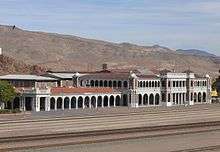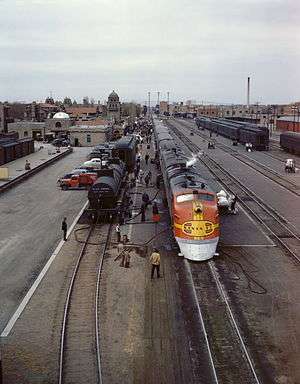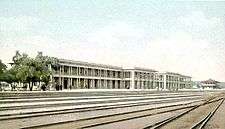Fred Harvey Company


The Fred Harvey Company was the owner of the Harvey House chain of restaurants, hotels, and other hospitality industry businesses alongside railroads in the western United States. The company traces its origins to the 1875 opening of two railroad eating houses located at Wallace, Kansas and Hugo, Colorado on the Kansas Pacific Railway. These cafés were opened by Fred Harvey, then a freight agent for the Chicago, Burlington & Quincy Railroad. The café operation ended within a year, but Harvey had been convinced of the potential profits from providing a high quality food and service at railroad eating houses. His longtime employer, the Burlington Railroad, declined his offer of establishing a system-wide eating house operation at all railroad meal stops, but the Atchison, Topeka & Santa Fe Railway (AT&SF) subsequently contracted with Harvey for several eating houses on an experimental basis.
In 1878, Harvey started the first of his eating house-hotel establishments along the AT&SF tracks in Florence, Kansas.[1][2] The rapid growth of the Harvey House chain soon followed.
Fred Harvey is credited with creating the first restaurant chain in the U.S. Harvey and his company also became leaders in promoting tourism in the American Southwest in the late 19th century. The company and its employees, including the famous waitresses who came to be known as Harvey Girls, successfully brought new higher standards of both civility and dining to a region widely regarded in the era as "the Wild West". The popularity of the Harvey Girls grew even stronger in 1946 when Judy Garland starred in the film version of Samuel Hopkins Adams’s novel The Harvey Girls.[3]
Despite the decline of passenger train patronage in the U.S. in the 20th century with the advent of the automobile, the company survived and prospered, by marketing its services to the motoring public. After 1926, Harvey Cars were used in the provision of "Indian Detours" services offered from a number of Harvey hotel locations. The company continued to adjust to the trends. In the late 1950s it operated, for the first 15 years, the then-new landmark Illinois Tollway "Oases" which were built above the Interstate 294 highway in the Chicago suburbs by Standard Oil of Indiana (Amoco).[4]
The Fred Harvey legacy was continued in the family until the death of a grandson in 1965.[5] Portions of the Fred Harvey Company have continued to operate since 1968 as part of a larger hospitality industry conglomerate.[6]
History


Before the inclusion of dining cars in passenger trains became common practice, a rail passenger's only option for meal service in transit was to patronize one of the roadhouses often located near the railroad's water stops. Fare typically consisted of nothing more than rancid meat, cold beans, and week-old coffee. Such poor conditions understandably discouraged many Americans from making the journey westward.
The subsequent growth and development of the Fred Harvey Company was closely related to that of AT&SF. Under the terms of an oral agreement, Harvey opened his first depot restaurant in Topeka, Kansas in January 1876. Railroad officials and passengers alike were impressed with Fred Harvey's strict standards for high quality food and first class service. As a result, AT&SF entered into subsequent contracts with Harvey wherein he was given unlimited funds to set up a series of what were dubbed "eating houses" along most of the route. At more prominent locations, these eating houses evolved into hotels, many of which survive today. By the late 1880s, there was a Fred Harvey dining facility located every 100 miles along the AT&SF.
AT&SF agreed to convey fresh meat and produce free-of-charge to any Harvey House via its own private line of refrigerator cars, the Santa Fe Refrigerator Despatch, and in them food was shipped from every corner of the U.S. The company maintained two dairy facilities (the larger of the two was situated in Las Vegas, New Mexico) to ensure a consistent and adequate supply of fresh milk. When dining cars began to appear on trains, AT&SF contracted with the Fred Harvey Company to operate the food service on the diners, and all AT&SF advertising proclaimed "Fred Harvey Meals All the Way".
Harvey's meals were served in sumptuous portions that provided a good value for the traveling public; for instance, pies were cut into fourths, rather than sixths, which was the industry standard at the time. The Harvey Company and AT&SF established a series of signals that allowed the dining room staff to make the necessary preparations to feed an entire train in just thirty minutes. Harvey Houses served their meals on fine China and Irish linens. Fred Harvey, a fastidious innkeeper, set high standards for efficiency and cleanliness in his establishments, personally inspecting them as often as possible. It was said that nothing escaped his notice, and he was even known to completely overturn a poorly set table. Male customers were required to wear a coat and tie in many of Harvey's dining rooms. The Harvey Houses served many a meal to GIs traveling on troop trains during World War II.
This mutually beneficial relationship, characterized as one of the most successful and influential business partnerships in the early American West, endured until 1963.
Facilities
.jpg)
For the Southwest, Harvey hired architects Charles Whittlesey and designer Mary Colter for influential landmark hotels in Santa Fe and Gallup, New Mexico. The Grand Canyon was the Santa Fe's main tourist destination and a major activity of the Harvey Company. Colter's rugged, landscape-integrated, and culturally appropriate design principles there influenced a generation of subsequent Western U.S. architecture through the National Park Service and Civilian Conservation Corps structures built during the Great Depression and after.
The Harvey team, with the backing of the Santa Fe, created an entire set of cultural images based on the region's distinctive, and often overlooked, artistic traditions of the Native American residents and the early Spanish settlers in the area. A pioneer in the field, Mary Colter designed a number of lobbies, restaurants, sales rooms, and other public spaces for the Santa Fe facilities. Especially noteworthy were Colter's buildings on the South Rim of the Grand Canyon, including lodges, souvenirs shops, and special lookout points, today on the National Register of Historic Places.
A rare woman architect in her day, Colter came to design complete hotels along the Santa Fe's main route. She was the architect for the 1930 La Posada Hotel in Winslow, Arizona, called "the last great railroad hotel built in America".
Colter's work with the Santa Fe, the National Park Service, and the Harvey Company blended Pueblo Revival, Mission Revival, Spanish Colonial Revival, and Rustic architectural styles along with Mexican carved-wood and hand-painted furnishings and Native American artistic motifs to help create a style widely popular in the American Southwest.
The last of her big projects was the Harvey House in the 1939 Los Angeles Union Station, dominated by a block-long recreation of a Navajo rug rendered in linoleum floor tile.
It has been suggested that the Harvey Houses originated the "blue-plate special", a daily low-priced complete meal served on a blue-patterned china plate; an 1892 Harvey menu mentions them, some thirty years before the term became widespread. In addition to the AT&SF, the Harvey Company operated dining facilities for the Gulf Coast & Santa Fe, Kansas Pacific, St. Louis-San Francisco, and the Terminal Railroad Association of St. Louis railways.
AT&SF maintained and operated a fleet of three passenger ferry boats that connected the railroad with San Francisco by water. Ships traveled the eight miles between the San Francisco Ferry Terminal and the railroad's Point Richmond terminal across the Bay. The service was originally established as a continuation of the company's named passenger train runs such as the Angel and the Saint. The larger two ships, the San Pablo and the San Pedro, each featured a newsstand-lunch counter located on the main deck, and a dining room on the upper deck. Meals, sandwiches, sweet rolls, pastries, and coffee were served. AT&SF discontinued ferry service in 1933 due to the effects of the Great Depression.
Harvey Girls

In 1883, Harvey implemented a policy of employing a female, white-only serving staff. He sought single, well-mannered, and educated American ladies, and placed ads in newspapers throughout the East Coast and Midwest for "white, young women, 18-30 years of age, of good character, attractive and intelligent". The girls were paid $17.50 a month (approximately $445 in 2016 dollars)[7] to start, plus room, board, and gratuity, a generous income by the standards of the time.
The women were subjected to a strict 10 p.m. curfew, administered by a senior Harvey Girl who assumed the role and responsibilities of house mother. The official starched black and white uniform (which was designed to diminish the female physique) consisted of a skirt that hung no more than eight inches off the floor, "Elsie" collars, opaque black stockings, and black shoes. The hair was restrained in a net and tied with a regulation white ribbon. Makeup of any sort was absolutely prohibited, as was chewing gum while on duty. Harvey Girls (as they soon came to be known) were required to enter into a one-year employment contract, and forfeited half their base pay should they fail to complete the term of service. Marriage was the most common reason for a girl to terminate her employment.
The restrictions maintained the clean-cut reputation of the Harvey Girls, and made them even more marriageable. However, the opportunity to leave their homes, to enjoy travel, have new experiences, and work outside the home was very liberating for thousands of young women. After the Harvey Houses closed in most cities, many former Girls (and today their daughters and granddaughters) joined in appreciation to carry on their legacy.
In a mythology that has grown around the Harvey Houses, these female employees are said to have helped to "civilize the American Southwest". This legend found expression in The Harvey Girls, a 1942 novel by Samuel Hopkins Adams and in the 1946 MGM musical film of the same name which was inspired by it.
Dining car service
Harvey initially balked at the suggestion that in-transit dining facilities be added to all AT&SF trains operating west of Kansas City. Eventually, Harvey agreed to support the railroad in this endeavor, and the California Limited became the first AT&SF's name trains to feature Harvey Company meal service en route. Later trains, such as the vaunted Super Chief, included dining cars (staffed by Fred Harvey Company personnel) as part of the standard passenger car complement right from the outset.
Selected Harvey Hotels
A list of some of the 84 Fred Harvey facilities:
- The Alvarado — Albuquerque, New Mexico; closed in 1969, demolished
- The Bisonte — Hutchinson, Kansas; closed in 1946
- The Casa del Desierto — Barstow, California; closed in 1959, refurbished 1999, operating as two museums and city offices
- The Hotel Castañeda — Las Vegas, New Mexico; closed in 1948, used in the 1984 film Red Dawn, purchased for restoration April 2014
- El Garces — Needles, California; closed in 1958, restored in 2014
- El Navajo — Gallup, New Mexico; demolished 1957
- El Ortiz — Lamy, New Mexico; closed in 1938
- El Otero — La Junta, Colorado; closed in 1948
- El Tovar — Grand Canyon, Arizona; still in operation
- El Vaquero — Dodge City, Kansas; closed in 1948
- The Havasu House — Seligman, Arizona; closed in 1955, demolished 2008
- The Escalante — Ash Fork, Arizona; closed in 1948, demolished in the 1970s
- The Fray Marcos — Williams, Arizona; the site is now The Grand Canyon Railway Hotel, designed to resemble the century-old depot that housed the original Fray Marcos
- La Fonda — Santa Fe, New Mexico; acquired by the Santa Fe Railway, leased to Fred Harvey in 1925; in operation, different owners
- Las Chavez — Vaughn, New Mexico; closed in 1936
- La Posada — Winslow, Arizona; closed in 1957; restored and reopened as a historic hotel
- The Sequoyah — Syracuse, Kansas; closed in 1936
- The Slaton Harvey House — Slaton, Texas; opened in 1912, restaurant closed in 1942, remained train depot before closing, went into disrepair and was to be demolished, was saved by a few locals, renovated, and reopened - currently in operation as an event center and bed & breakfast
- Los Angeles Union Station Harvey House, soon to be restored as a gastropub
Separation from AT&SF
Beginning in the 1930s, the Fred Harvey Company began expanding into other locations beyond the reach of AT&SF, and often away from rail passenger routes. Restaurants were opened in such locations as the Chicago Union Station (the largest facility operated by Harvey), San Diego Union Station, the San Francisco Bus Terminal, and the Albuquerque International Airport; the last of these was established at the Los Angeles Union Passenger Terminal in 1939, and could accommodate nearly 300 diners.
From 1959 until 1975, the Fred Harvey organization operated a series of restaurants in the Illinois Tollway oasis, a set of highway rest stops built on bridges over the tollway. The original Fred Harvey company, as well as the company's close affiliation with AT&SF, lasted until 1968 when it was purchased by the Amfac Corporation of Hawaii. Amfac was renamed Xanterra Parks & Resorts in 2002.[8][9] In 2006, Xanterra purchased the Grand Canyon Railway and its properties.
See also
- Atchison, Topeka and Santa Fe Railway and its passenger train service
- Dining aboard the Super Chief
- Blue-plate special
- Van Noy Railway News and Hotel Company
- Harvey House in Florence, Kansas
References
- ↑ Harvey House (Florence, Kansas) - NRHP Application (0.4MB PDF)
- ↑ Harvey House (Florence, Kansas) - NRHP Photos (1.0MB PDF)
- ↑ http://www.imdb.com/title/tt0038589/
- ↑ "Illinois Tollway Oasis History". Panix.com. Retrieved 2014-06-10.
- ↑ "Milestones: Jun. 18, 1965". Time. June 18, 1965.
- ↑ "Our Fred Harvey Legacy | Xanterra Parks & Resorts, Inc". Xanterra.com. Retrieved 2015-11-27.
- ↑ Federal Reserve Bank of Minneapolis Community Development Project. "Consumer Price Index (estimate) 1800–". Federal Reserve Bank of Minneapolis. Retrieved October 21, 2016.
- ↑ Xanterra Parks & Resorts Brings Professional Management to National and State Parks; and Resorts
- ↑ Xanterra's Fred Harvey Legacy
Further reading
- Duke, Donald (1997). Santa Fe...The Railroad Gateway to the American West, Volume 2. Golden West Books, San Marino, CA. ISBN 0-87095-110-6.
- Foster, George H. and Peter C. Weiglin (1992). The Harvey House Cookbook: Memories of Dining along the Santa Fe Railroad. Longstreet Press, Atlanta, GA. ISBN 1-56352-357-4.
- Gustafson, Lee and Phil Serpico (1992). Santa Fe Coast Lines Depots: Los Angeles Division. Omni Publications, Palmdale, CA. ISBN 0-88418-003-4.
- Henderson, James David (1969). Meals by Fred Harvey. Texas Christian University Press, Fort Worth, TX.
- Poling-Kempes, Lesley (1989). The Harvey Girls, Women Who Opened the West. Paragon House, New York, NY. ISBN 1-55778-064-1.
- Porterfield, James D. (1993). Dining by Rail: The History and Recipes of America's Golden Age of Railroad Cuisine. St. Martin's Press, New York, NY. ISBN 0-312-18711-4.
- Thomas, D.H. (1978). The Southwestern Indian Detours. Hunter Publishing Co., Phoenix, AZ. ISBN 0-918126-11-8.
- Stephen Fried. Appetite for America: How Visionary Businessman Fred Harvey Built a Railroad Hospitality Empire That Civilized the Wild West (Bantam; 2010) 518 pages;
External links
| Wikimedia Commons has media related to Harvey House. |
- Harvey Girl Historical Society
- A Harvey House home page
- Fred Harvey Collection - University of Arizona
- La Posada - Winslow, Arizona
- Friends of the Fred Harvey Company (wiki)
- The Harvey Girls at the Internet Movie Database.
- Encyclopedia of Oklahoma History and Culture - Harvey Girls
- Harvey Girls Changed the West Borderlands (EPCC)